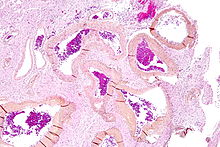User:Mr. Ibrahem/Arteriovenous malformation
| Arteriovenous malformation | |
|---|---|
| Other names | AVM |
 | |
| Micrograph of an arteriovenous malformation in the brain. HPS stain. | |
| Specialty | Neurosurgery |
| Symptoms | None, pain, seizures, stroke symptoms[1] |
| Complications | Bleeding, steal syndrome, heart failure[2][1] |
| Causes | Unknown[1] |
| Diagnostic method | Medical imaging[1] |
| Differential diagnosis | Cavernous malformations, capillary telangiectasias, infantile hemangioma, capillary malformations, arteriovenous fistula[2][1] |
| Treatment | Surgical removal, endovascular embolization, stereotactic radiosurgery[2][1] |
Arteriovenous malformation is an abnormal connection between an artery and vein, without intervening capillaries.[2] Often no symptoms are present, though sometimes pain, seizures, or stroke symptoms may occur.[1] Complications may include bleeding (~4% of cases), steal syndrome, or heart failure.[2][1]
Types include AVMs of the brain and spinal cord, though any part of the body may be involved.[2][1] The cause in most cases is unclear.[1] Risk factors for brain AVMs include hereditary hemorrhagic telangiectasia.[2] Diagnosis is usually confirmed by medical imaging.[1]
AVMs may be treated with surgical removal, endovascular embolization, or stereotactic radiosurgery.[2][1] If issues have not occurred by the age of 50, they are unlikely to occur.[1] Cerebral AVMs newly occur in about 1.3 people per 100,000 per years.[2] Males and females are affected equally.[3] Death occurs as a result, in about 1% of those affected.[1] AVMs were first described in the mid-1800s.[4]
References[edit]
- ^ a b c d e f g h i j k l m n "Arteriovenous Malformations". www.hopkinsmedicine.org. Retrieved 27 February 2021.
- ^ a b c d e f g h i Zyck, S; Sampath, R (January 2020). "Arteriovenous Malformations". PMID 30285374.
{{cite journal}}: Cite journal requires|journal=(help) - ^ "Arteriovenous Malformation". NORD (National Organization for Rare Disorders). Retrieved 27 February 2021.
- ^ Dieter, Robert S.; Jr, Raymond A. Dieter (2013). Endovascular Interventions: A Case-Based Approach. Springer Science & Business Media. p. 39. ISBN 978-1-4614-7312-1.
